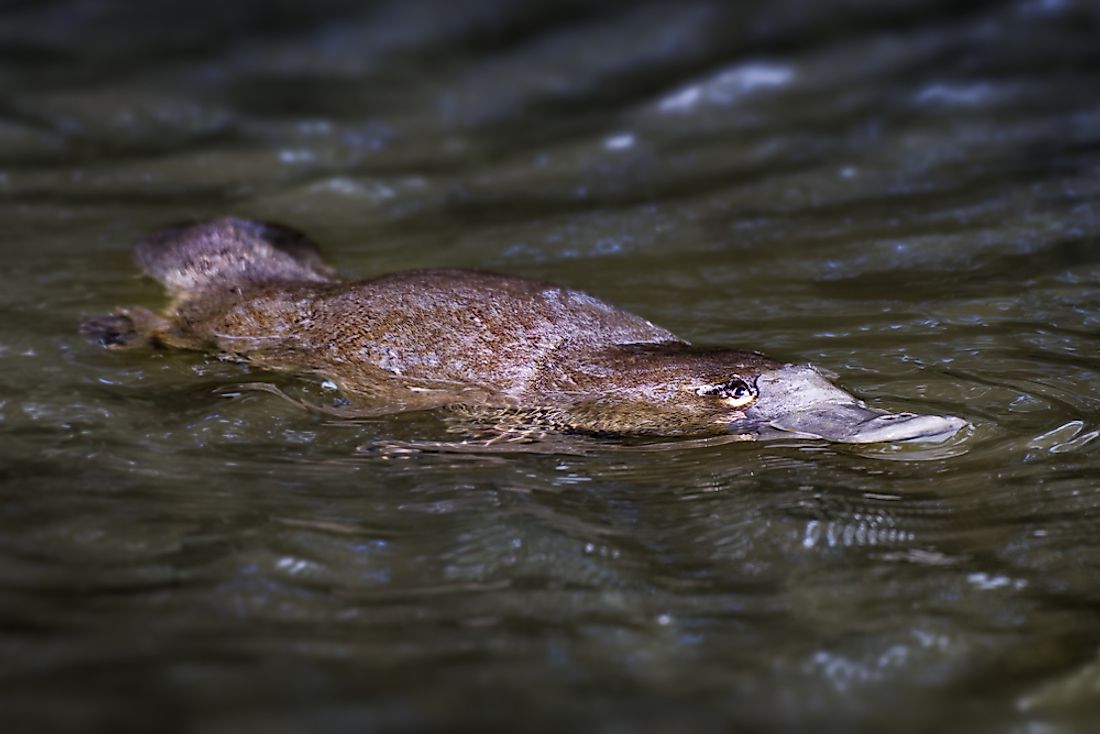Where Does the Platypus Live?

The platypus is a semiaquatic mammal that lay eggs. The common residence for this animal include the lakes and streams of eastern Australia. They can also be found in Tasmania. They are the one of the few mammals that reproduce by lay eggs, known as monotremes. Another name for platypus is the duck-billed platypus. When platypus was first discovered, its unique appearance caused considerable confusion and uncertainty between European natural historians and scientists. Many thought that the creature was not real. Platypus is one of the distinctive animals in the animal domain. Its body is sleek and furry. It has a flat bill and a paddle-shaped tail. Besides, a platypus has webbed feet that contain toxic spurs, dense fur, and a sensitive, flexible bill. Other facts about platypuses are described in the following sections.
6. Physical Description
The female platypus is smaller than the male platypus; the males can measure up to 60 cm long from the tip of the bill to the tip of the tail. Typically, females are 370 to 550 millimeters, and males are 400 to 630 millimeters long. The weight for females ranges from 600 to 1,700 grams, while the males weigh about 800 to 3,000 grams. The platypuses have heavy skeletons, which look like the ones for the reptiles; both the platypuses and reptiles’ skeletons have pectoral girdles and legs that are spread out. A young platypus has teeth which drop out in their first interaction with water.
One adaptation that helps the platypuses stay warm in water is its dense, thick fur. Mostly, the fur is dark brown except for the patch of lighter-colored fur on the lower side, and lighter fur nearby each eye. When platypuses are swimming, their front feet help them since they have another skin that acts as a paddle. When they are on land, their claws are made more strong by the webbing retracts. The awkward walk of these animals on their knuckles keeps the webbing from harm. The billed platypuses are rubbery, flexible, and have a smooth touch that feels like suede. It has many receptors (held by the skin of their bill) that help the animal navigate when in the water and discover the movement of possible food such as the shrimp.
5. Behavior
Platypuses navigate with the tails and hind feet and swim with the front feet. Platypuses can move swim very well in the water as compared to when they are moving across the land. Notably, they use about 30% additional energy while moving on land than when swimming through the water. When they are disturbed, platypuses can make a relatively quiet growling sound. The animal can determine the direction of the electric source, explaining why they exhibit the side-by-side movement of their heads when looking for food. The platypuses sleep during the day, and they stay in the burrows when they are not looking for food. Platypuses can take as long as ten to twelve hours hunting for food.
4. Habitat and Range
These animals are found only in a small part of the world. Freshwater areas that run into and out the eastern and southern coast of Australia and island of Tasmania are homes to the platypuses. They toddle onto the watersides to dig burrows using their claws, mostly when they are on the water. The other habitats for platypuses include ledges, under rocks, debris, and roots. Even though platypuses mostly stay in the water, they cannot entirely stay underwater, but they only stay for 0.5 to 2.3 minutes inside the water. They have waterproof fur skin that shelters their eyes and ears. In addition, their noses stay shut when they in the water to enhance prevention of water from entering. The platypuses can survive in climate extremes even though they only live on one side of the continent. Platypuses have been found in tropical rainforests, lowlands, plateaus, and the cold mountains of Tasmania as well as the Australian high mountains. The tails of the platypuses store more fat for energy while the thick, waterproof fur keeps the platypuses warm in the cold climatic conditions.
3. Diet
Platypuses are carnivorous; their food include insects and shellfish in water. Their sensitized bills help them discover food in the muddy bottom of the water as they swim. Platypuses have only grinding plates since they have no teeth and so when they find something for food, they scoop them up in their beaks then store in the cheek pouches and swim to the surface. They then use any pebbles or mud they scooped up alongside their prey/food at the bottom of the water to smash the food into digestive parts.
2. Venom
Platypuses are one of the very few mammals that secrete venom. At the back of the males’ hind feet, there is a spur that is joined to the venom-secreting glands; platypus uses them against animals that prey on them or in battles with other males during breeding. According to the Australian Platypus Conservatory, the poison venom and the spurs are essential to the male platypuses while they ate striving to breed. The venom can cause severe swelling and intense pain but not life menacing to humans.
1. Reproduction
The female platypus excavates down inside the ground on the waterside and covers herself into one of her tunnel rooms when it is time to breed. She will then lay eggs and put them between her tail and her rump to provide warmth. During this period, they use fats stored in the tails for food supply. The eggs, after around ten days, hatch and then babies begin to suckle for three to four months. Baby platypuses are capable of swimming on their own at the time they start looking for other food apart from their mother’s milk.











